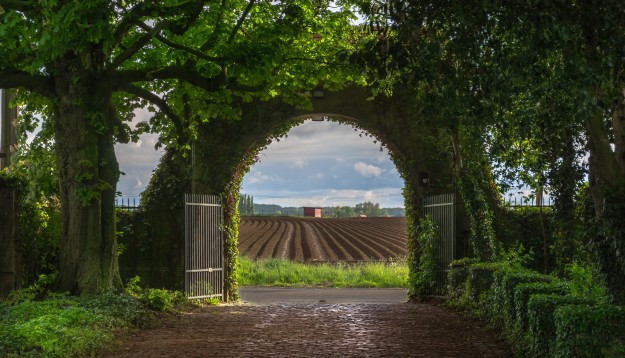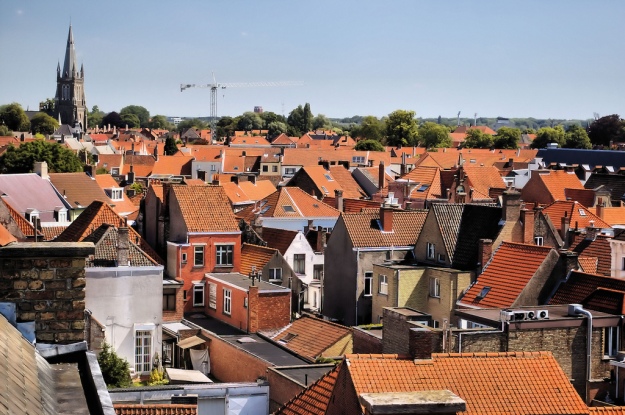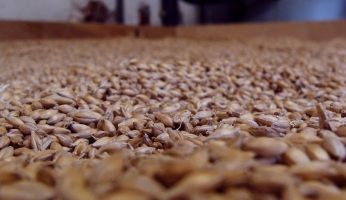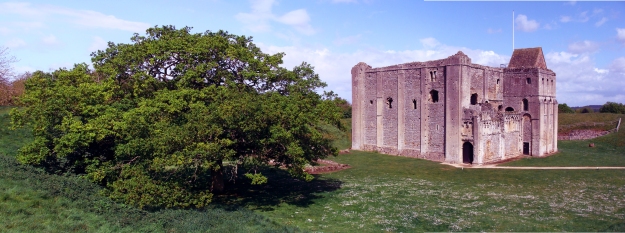Something strange brews in the Senne valley. In the cooler months, brewers open the shutters of their breweries and welcome in whatever is borne on the breeze. Foaming wort bursts forth from old oak casks, spilling over the cobwebs networked between barrels. Some of the beer has been aging here for three years. The master brewer takes stock of each vintage and blends them together into a final concoction that springs to life once more in the bottle. Lambic and gueuze are the defining drinks of Brussels and Brabant, and this small patch of earth is the only place in the world where it can be brewed. Continue reading
In Flanders Fields (Part 3)
After a rousing breakfast surrounded by sonorous Flemish voices, I cycled my increasingly heavy bike through the Brouwershuis’ verdant gate. In one day I’d added the weight of a dozen beer bottles, and it was starting to take a toll on the handling of the bike. Fortunately I hadn’t much farther to go, and quickly I came to the city of Poperinge.

Front gate at the Brouwershuis. Photo: TJ Ryals
In Flanders Fields (Part 2)
I left Johannes’ home bound for breweries and hop fields. My second day of riding (the map of my full route is in Part 1) would take me past De Dolle Brouwers and De Struise Brouwers before having a rest at In De Vrede, the café of Sint-Sixtusabdij, and finally coming to Brouwerij Sint-Bernardus where I would spend the night in the heart of the hop-growing region of Belgium called Poperinge. Unfortunately the first two breweries only open up their taprooms and tours on weekends, but as Johannes said before I pedaled away, “You never know – maybe they’ll see your cycle and the rain and feel sympathetic.” With that hope, I headed in the direction of Esen.
In Flanders Fields (Part 1)
I took off from Brugge along a broad canal headed in the direction of the Zwin. By my guess, the channel used to bring ships in from the coast via the Zwin back when Brugge was a major inland port, but over time the Zwin silted up and Brugge lost its status as a hot spot of trade. But the Zwin still sees its fair share of comings and goings, only these days the traffic is comprised of birds rather than ships. It brought me to the northernmost corner of West Flanders, so much that I crossed into the Netherlands and back into Belgium twice in the course of cycling there.
Bruges Under the Half Moon
Henri Maes opened Brouwerij De Halve Maan in 1856 on the promise from his uncle of a contract to supply Sint-Janshospitaal in Brugge with beer. High above the houses, on the edge of the small city, the rooftop of the brewery offers what may be the best view of the contortion of canals, cobbles, gables, and red-shingled roofs. Some of the shingles are new, but each house wears the same uniform cap.
The Nature of Norfolk (Part 3)
There being so many farms in Norfolk, one might wonder just what they’re growing. After my own heart, the farmers of Norfolk produce much of the barley Crisp turns into high quality English malts that I’ve used in my own beers in Brooklyn. Branthill Farms supplies over a dozen brewers in Norfolk with Maris Otter malt and operates The Real Ale Shop and solar-powered Branthill Micro Maltings. Naturally, to better get a taste for Norfolk, I made finding the shop a high priority.
The Nature of Norfolk (Part 2)
As mentioned in the previous installment of this series, Norfolk’s history has been well preserved. But the heritage that the region wears on its sleeve is not the only offering of culture in the area. Many of Norfolk’s residents are actively working to celebrate the region, and those that I met helped me feel welcome there.
The Nature of Norfolk (Part 1)
I spent the past weekend cycling the Norfolk Coast Cycleway, taking my bicycle by train to King’s Lynn on Saturday morning and returning by train from Great Yarmouth Sunday evening. In exchange for the offering of my weekend and my sore body, I received the privilege of enjoying miles of coastline, living history in every town, and the friendly acquaintance of its residents. Even investing my whole weekend into the trip and covering such a distance, I still felt like I’d only just gotten a small peak at Norfolk. Nonetheless, it was my best cycle yet. Continue reading
Cultured Pickle
I mentioned in my post on starting up a sourdough culture that I was also having a go at fermenting sauerkraut. Though that first attempt came out too salty due to an oversight on my part, my follow-up attempt tasted delicious and was very easy to make. Crisp and tangy, I used it for sandwiches, as a side, or even just ate it for a snack. I shared a jar with one of the other researchers in the lab who said he was going to eat with some pork. The success of that experiment made me start contemplating other pickle possibilities.
Yet More Fermented Food: Yogurt
In the recipe I recently posted for oatmeal scones, I included whey as an ingredient. Whey is not something most people have hanging around, so where did mine come from and why was I using it? The short answer is that I’ve been making my own Greek yogurt, and as a result of the straining process I end up with a lot of waste whey. But that whey is not really waste; its flavor and acidity give it many uses in the kitchen, and it still contains some nutrition to boot. I’ll get back to whey later – for now let’s get to the yogurt.




